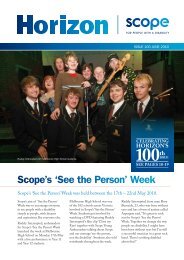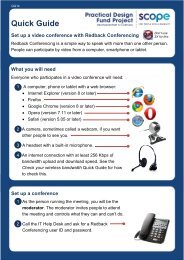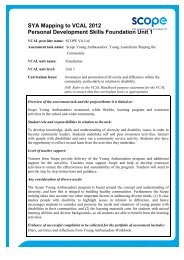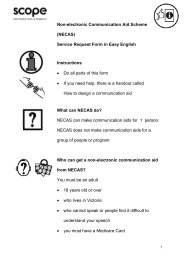Positive behaviour support Getting it right from the start
Positive behaviour support Getting it right from the start
Positive behaviour support Getting it right from the start
You also want an ePaper? Increase the reach of your titles
YUMPU automatically turns print PDFs into web optimized ePapers that Google loves.
44 <strong>Pos<strong>it</strong>ive</strong> <strong>behaviour</strong> <strong>support</strong>: <strong>Getting</strong> <strong>it</strong> <strong>right</strong> <strong>from</strong> <strong>the</strong> <strong>start</strong> - Facil<strong>it</strong>ators reference manual<br />
PowerPoint 63*<br />
Strategies used by effective communication partners 9<br />
• Know <strong>the</strong> person’s level of communicative abil<strong>it</strong>y—what <strong>it</strong> means if <strong>the</strong> person is an<br />
intentional or unintentional communicator or if <strong>the</strong> person has basic l<strong>it</strong>eracy. Knowledge<br />
and understanding of <strong>the</strong> person’s communicative abil<strong>it</strong>y will help ensure communication<br />
w<strong>it</strong>h <strong>the</strong> person is meaningful.<br />
• Remove any distractions before talking to <strong>the</strong> person (e.g. turn down <strong>the</strong> volume on <strong>the</strong><br />
television or radio).<br />
• Get <strong>the</strong> person’s attention (e.g. using a touch cue, making eye contact w<strong>it</strong>h <strong>the</strong> person).<br />
• Use clear simple language, but don’t be condescending.<br />
• Keep instructions specific and pos<strong>it</strong>ive. Talk to <strong>the</strong> person about what to do, not what not<br />
to do. For example, ‘Tom walk beside <strong>the</strong> pool’ instead of ‘don’t run by <strong>the</strong> pool’. Avoid saying<br />
‘We will go for a coffee later’ give <strong>the</strong> person a time ‘We will go for a coffee after lunch’.<br />
• If you have broken down <strong>the</strong> instruction and <strong>the</strong> person is still experiencing difficulty<br />
processing <strong>it</strong>, model or demonstrate to <strong>the</strong> person what you are saying.<br />
• Break down complex instructions into separate steps. For example, if providing a three<br />
part instruction, provide one part of <strong>the</strong> instruction at a time.<br />
• Be careful that your body language and facial expressions don’t send conflicting<br />
messages: for example, having a grumpy look on your face when your message does<br />
not have an angry or grumpy tone.<br />
• Always use environmental cues. For example be in <strong>the</strong> k<strong>it</strong>chen when talking about<br />
making dinner.<br />
• Use natural gestures or key word signing when talking w<strong>it</strong>h <strong>the</strong> person. Remember<br />
always to speak and sign.<br />
• Supplement spoken messages w<strong>it</strong>h visual cues such as <strong>the</strong> real object, photo, line drawing<br />
that is being talked about to help <strong>the</strong> person understand what is happening next or what<br />
you are talking about. Remember to find out what visual cues are most meaningful to <strong>the</strong><br />
person, as not all people are able to understand photographs or line drawings.<br />
• Allow <strong>the</strong> person time to respond. People w<strong>it</strong>h disabil<strong>it</strong>ies may not only take time to<br />
communicate <strong>the</strong>ir message but may also require time to listen to <strong>the</strong>ir communication<br />
partner, formulate and communicate a response.<br />
• If <strong>the</strong> person has difficulty w<strong>it</strong>h time concepts, use times of <strong>the</strong> day <strong>the</strong>y know, or provide<br />
<strong>the</strong> person w<strong>it</strong>h visual ways to mark time.<br />
• Use visual systems to help <strong>the</strong> person process and respond in times of stress or illness.<br />
For example an AAC system such as a social story will <strong>support</strong> <strong>the</strong> person to remember<br />
how to relax and react in a stressful s<strong>it</strong>uation. This also provides <strong>the</strong> person w<strong>it</strong>h ways to<br />
control and <strong>support</strong> <strong>the</strong>mselves independently.<br />
• If you have broken down <strong>the</strong> instruction and <strong>the</strong> person is still experiencing difficulty<br />
processing <strong>it</strong>, model/demonstrate what you are saying.<br />
9. Butterfield, N., Arthur, M ad Sigafoos, J. (1995) Partners in every day communicative exchanges.

















